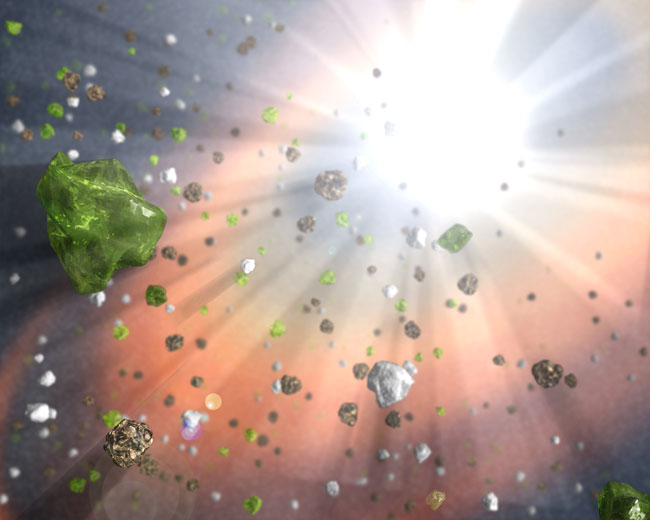
Like enormous jewel factories in the sky, the chaotic environments around some supermassive black holes crank out prodigious amounts of glass, rubies and sapphires, a new study finds.
The inevitable breakdown of these materials into simpler components could account for much of the space dust in the universe—dust that is recycled to make stars, planets, and life.
Traces of these minerals, as well as sand and marble, were recently found by scientists analyzing light from the region around a nearby supermassive black hole using NASA's Spitzer Space Telescope. The black hole was embedded in a quasar, a highly active and incredibly bright galaxy under construction.
"We were surprised to find what appears to be freshly made dust entrained in the winds that blow away from supermassive black holes," said study team member Ciska Markwick-Kemper of the University of Manchester in the U.K.
The finding, to be detailed in an upcoming issue of Astrophysical Journal, could also help solve the mystery of where dust used to build the first generation of stars in the universe came from.
The space dust in our corner of the universe is thought to have been created when ancient stars resembling massive versions of our sun exploded as supernovas at the ends of their lives. But when the universe was new, sun-like stars hadn't been around long enough to die and make dust. So where did the dust needed to make those stars come from?
One idea is that the dust came from quasars, which are supermassive black holes surrounded by dusty, doughnut-shaped clouds and lots of radiation. They are the most active, budding galaxies known, where gravity lures material in but the resulting pressure blows material away on a constant cosmic tug-of-war that results in high rates of star formation and the creation of new elements.
Get the Space.com Newsletter
Breaking space news, the latest updates on rocket launches, skywatching events and more!
"Quasars are like the Cookie Monster," said study team member Sarah Gallagher of the University of California, Los Angeles. "They can consume less matter than they can spit out in the form of winds."
To test this theory, Gallagher and her team used Spitzer to investigate PG2112+059, a quasar located in the center of a galaxy about 8 billion light-years away. They found evidence of sand and minerals such as rubies that do not last long in the harsh environment of space, suggesting they were freshly made.
The researchers plan to look for evidence of dust around other quasars to strengthen their case. It's also possible, they say, that quasars were not the only source of dust in the early universe.
"Supernovas might have been more important for creating dust in some environments, while quasars were more important in others," Markwick-Kemper said.
- Top 10 Star Mysteries
- Vote Now: The Strangest Things in Space
- VIDEO: Supernovas: Creator and Destroyer
Join our Space Forums to keep talking space on the latest missions, night sky and more! And if you have a news tip, correction or comment, let us know at: community@space.com.
Ker Than is a science writer and children's book author who joined Space.com as a Staff Writer from 2005 to 2007. Ker covered astronomy and human spaceflight while at Space.com, including space shuttle launches, and has authored three science books for kids about earthquakes, stars and black holes. Ker's work has also appeared in National Geographic, Nature News, New Scientist and Sky & Telescope, among others. He earned a bachelor's degree in biology from UC Irvine and a master's degree in science journalism from New York University. Ker is currently the Director of Science Communications at Stanford University.









